fuel pressure Seat Altea 2012 User Guide
[x] Cancel search | Manufacturer: SEAT, Model Year: 2012, Model line: Altea, Model: Seat Altea 2012Pages: 313, PDF Size: 4.47 MB
Page 249 of 313
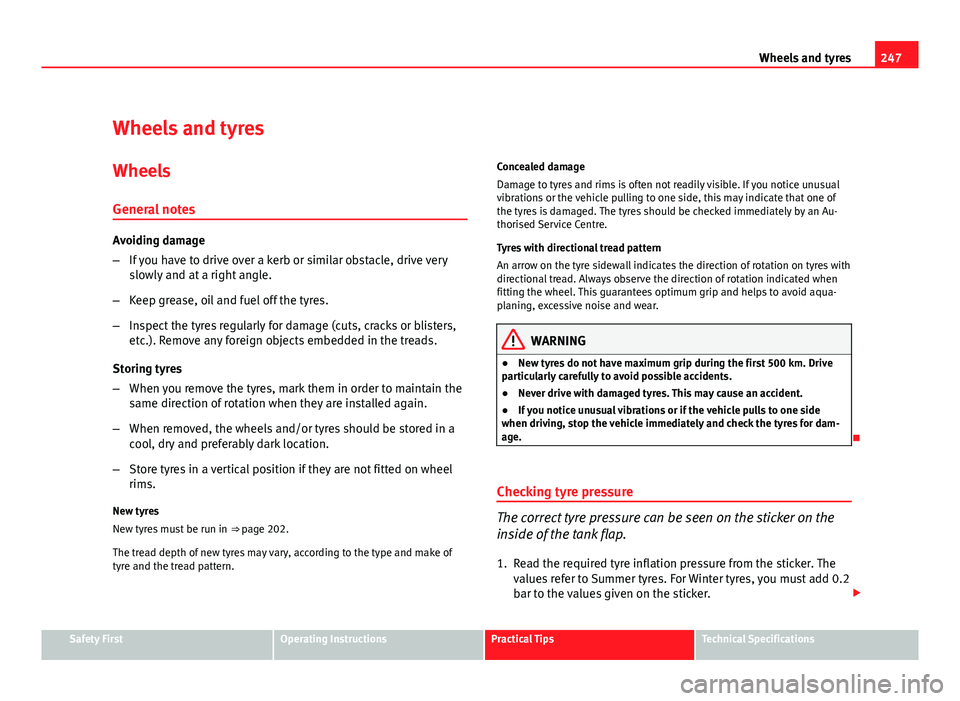
247
Wheels and tyres
Wheels and tyres
Wheels
General notes
Avoiding damage
ŌĆō If you have to drive over a kerb or similar obstacle, drive very
slowly and at a right angle.
ŌĆō Keep grease, oil and fuel off the tyres.
ŌĆō Inspect the tyres regularly for damage (cuts, cracks or blisters,
etc.). Remove any foreign objects embedded in the treads.
Storing tyres
ŌĆō When you remove the tyres, mark them in order to maintain the
same direction of rotation when they are installed again.
ŌĆō When removed, the wheels and/or tyres should be stored in a
cool, dry and preferably dark location.
ŌĆō Store tyres in a vertical position if they are not fitted on wheel
rims.
New tyres
New tyres must be run in ŌćÆŌĆŖpage 202.
The tread depth of new tyres may vary, according to the type and make of
tyre and the tread pattern. Concealed damage
Damage to tyres and rims is often not readily visible. If you notice unusual
vibrations or the vehicle pulling to one side, this may indicate that one of
the tyres is damaged. The tyres should be checked immediately by an Au-
thorised Service Centre.
Tyres with directional tread pattern
An arrow on the tyre sidewall indicates the direction of rotation on tyres with
directional tread. Always observe the direction of rotation indicated when
fitting the wheel. This guarantees optimum grip and helps to avoid aqua-
planing, excessive noise and wear.
WARNING
ŌŚÅ New tyres do not have maximum grip during the first 500 km. Drive
particularly carefully to avoid possible accidents.
ŌŚÅ Never drive with damaged tyres. This may cause an accident.
ŌŚÅ If you notice unusual vibrations or if the vehicle pulls to one side
when driving, stop the vehicle immediately and check the tyres for dam-
age.
’āÉ
Checking tyre pressure
The correct tyre pressure can be seen on the sticker on the
inside of the tank flap.
1. Read the required tyre inflation pressure from the sticker. The values refer to Summer tyres. For Winter tyres, you must add 0.2
bar to the values given on the sticker. ’éŻ
Safety FirstOperating InstructionsPractical TipsTechnical Specifications
Page 250 of 313
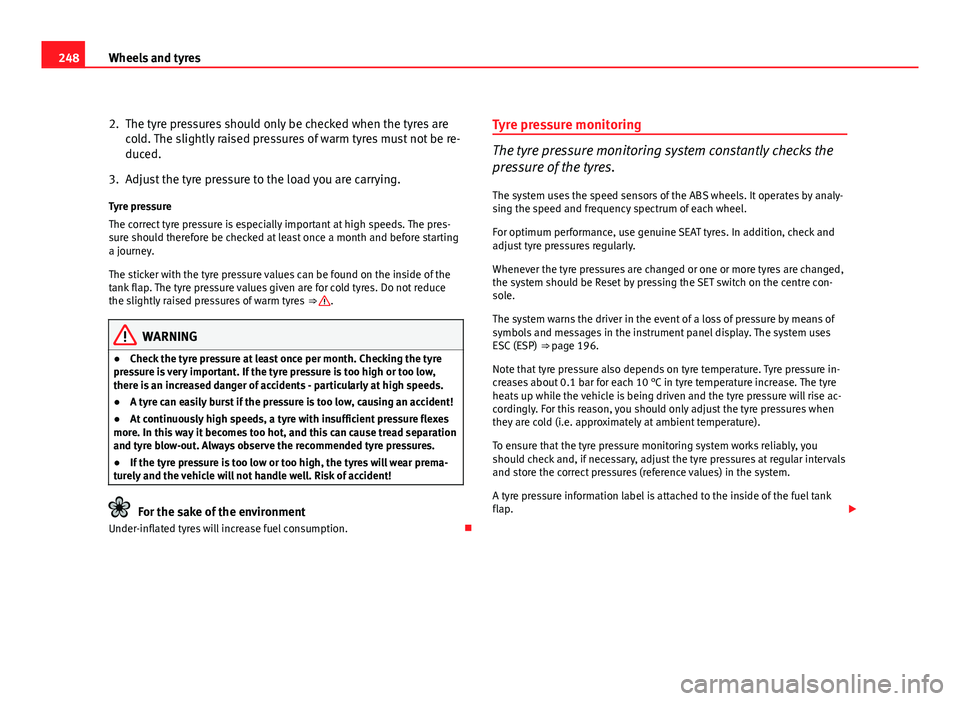
248Wheels and tyres
2. The tyre pressures should only be checked when the tyres are
cold. The slightly raised pressures of warm tyres must not be re-
duced.
3. Adjust the tyre pressure to the load you are carrying.
Tyre pressure
The correct tyre pressure is especially important at high speeds. The pres-
sure should therefore be checked at least once a month and before starting
a journey.
The sticker with the tyre pressure values can be found on the inside of the
tank flap. The tyre pressure values given are for cold tyres. Do not reduce
the slightly raised pressures of warm tyres ŌćÆŌĆŖ
.
WARNING
ŌŚÅ Check the tyre pressure at least once per month. Checking the tyre
pressure is very important. If the tyre pressure is too high or too low,
there is an increased danger of accidents - particularly at high speeds.
ŌŚÅ A tyre can easily burst if the pressure is too low, causing an accident!
ŌŚÅ At continuously high speeds, a tyre with insufficient pressure flexes
more. In this way it becomes too hot, and this can cause tread separation
and tyre blow-out. Always observe the recommended tyre pressures.
ŌŚÅ If the tyre pressure is too low or too high, the tyres will wear prema-
turely and the vehicle will not handle well. Risk of accident!
For the sake of the environment
Under-inflated tyres will increase fuel consumption. ’āÉTyre pressure monitoring
The tyre pressure monitoring system constantly checks the
pressure of the tyres.
The system uses the speed sensors of the ABS wheels. It operates by analy-
sing the speed and frequency spectrum of each wheel.
For optimum performance, use genuine SEAT tyres. In addition, check and
adjust tyre pressures regularly.
Whenever the tyre pressures are changed or one or more tyres are changed,
the system should be Reset by pressing the SET switch on the centre con-
sole.
The system warns the driver in the event of a loss of pressure by means of
symbols and messages in the instrument panel display. The system uses
ESC (ESP) ŌćÆŌĆŖpage 196.
Note that tyre pressure also depends on tyre temperature. Tyre pressure in-
creases about 0.1 bar for each 10 ┬░C in tyre temperature increase. The tyre
heats up while the vehicle is being driven and the tyre pressure will rise ac-
cordingly. For this reason, you should only adjust the tyre pressures when
they are cold (i.e. approximately at ambient temperature).
To ensure that the tyre pressure monitoring system works reliably, you
should check and, if necessary, adjust the tyre pressures at regular intervals
and store the correct pressures (reference values) in the system.
A tyre pressure information label is attached to the inside of the fuel tank
flap. ’éŻ
Page 251 of 313
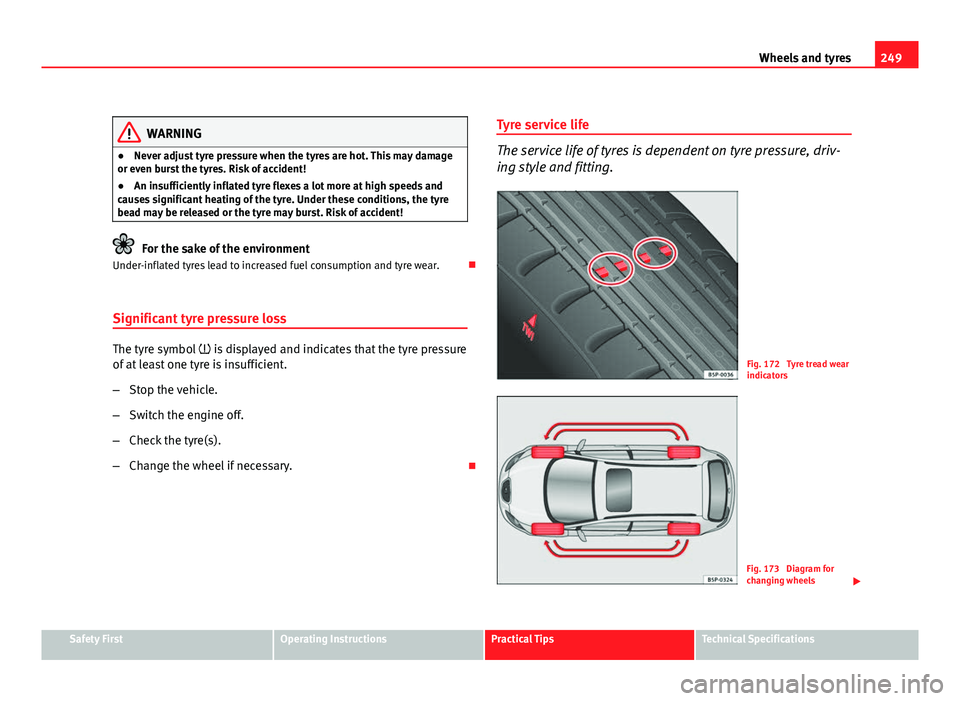
249
Wheels and tyres
WARNING
ŌŚÅ Never adjust tyre pressure when the tyres are hot. This may damage
or even burst the tyres. Risk of accident!
ŌŚÅ An insufficiently inflated tyre flexes a lot more at high speeds and
causes significant heating of the tyre. Under these conditions, the tyre
bead may be released or the tyre may burst. Risk of accident!
For the sake of the environment
Under-inflated tyres lead to increased fuel consumption and tyre wear. ’āÉ
Significant tyre pressure loss
The tyre symbol ’āć is displayed and indicates that the tyre pressure
of at least one tyre is insufficient.
ŌĆō Stop the vehicle.
ŌĆō Switch the engine off.
ŌĆō Check the tyre(s).
ŌĆō Change the wheel if necessary. ’āÉTyre service life
The service life of tyres is dependent on tyre pressure, driv-
ing style and fitting.
Fig. 172 Tyre tread wear
indicators
Fig. 173 Diagram for
changing wheels
’éŻ
Safety FirstOperating InstructionsPractical TipsTechnical Specifications
Page 252 of 313
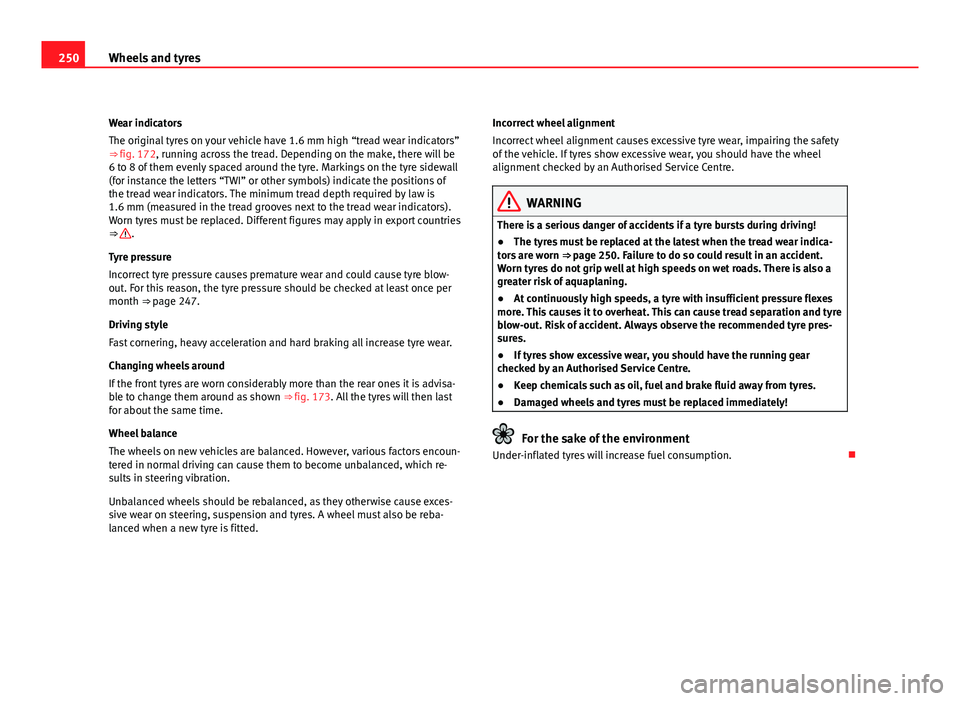
250Wheels and tyres
Wear indicators
The original tyres on your vehicle have 1.6 mm high ŌĆ£tread wear indicatorsŌĆØ
ŌćÆŌĆŖfig. 172, running across the tread. Depending on the make, there will be
6 to 8 of them evenly spaced around the tyre. Markings on the tyre sidewall
(for instance the letters ŌĆ£TWIŌĆØ or other symbols) indicate the positions of
the tread wear indicators. The minimum tread depth required by law is
1.6 mm (measured in the tread grooves next to the tread wear indicators).
Worn tyres must be replaced. Different figures may apply in export countries
ŌćÆŌĆŖ
.
Tyre pressure
Incorrect tyre pressure causes premature wear and could cause tyre blow-
out. For this reason, the tyre pressure should be checked at least once per
month ŌćÆŌĆŖpage 247.
Driving style
Fast cornering, heavy acceleration and hard braking all increase tyre wear.
Changing wheels around
If the front tyres are worn considerably more than the rear ones it is advisa-
ble to change them around as shown ŌćÆŌĆŖfig. 173. All the tyres will then last
for about the same time.
Wheel balance
The wheels on new vehicles are balanced. However, various factors encoun-
tered in normal driving can cause them to become unbalanced, which re-
sults in steering vibration.
Unbalanced wheels should be rebalanced, as they otherwise cause exces-
sive wear on steering, suspension and tyres. A wheel must also be reba-
lanced when a new tyre is fitted. Incorrect wheel alignment
Incorrect wheel alignment causes excessive tyre wear, impairing the safety
of the vehicle. If tyres show excessive wear, you should have the wheel
alignment checked by an Authorised Service Centre.
WARNING
There is a serious danger of accidents if a tyre bursts during driving!
ŌŚÅ The tyres must be replaced at the latest when the tread wear indica-
tors are worn ŌćÆŌĆŖpage 250. Failure to do so could result in an accident.
Worn tyres do not grip well at high speeds on wet roads. There is also a
greater risk of aquaplaning.
ŌŚÅ At continuously high speeds, a tyre with insufficient pressure flexes
more. This causes it to overheat. This can cause tread separation and tyre
blow-out. Risk of accident. Always observe the recommended tyre pres-
sures.
ŌŚÅ If tyres show excessive wear, you should have the running gear
checked by an Authorised Service Centre.
ŌŚÅ Keep chemicals such as oil, fuel and brake fluid away from tyres.
ŌŚÅ Damaged wheels and tyres must be replaced immediately!
For the sake of the environment
Under-inflated tyres will increase fuel consumption. ’āÉ
Page 253 of 313
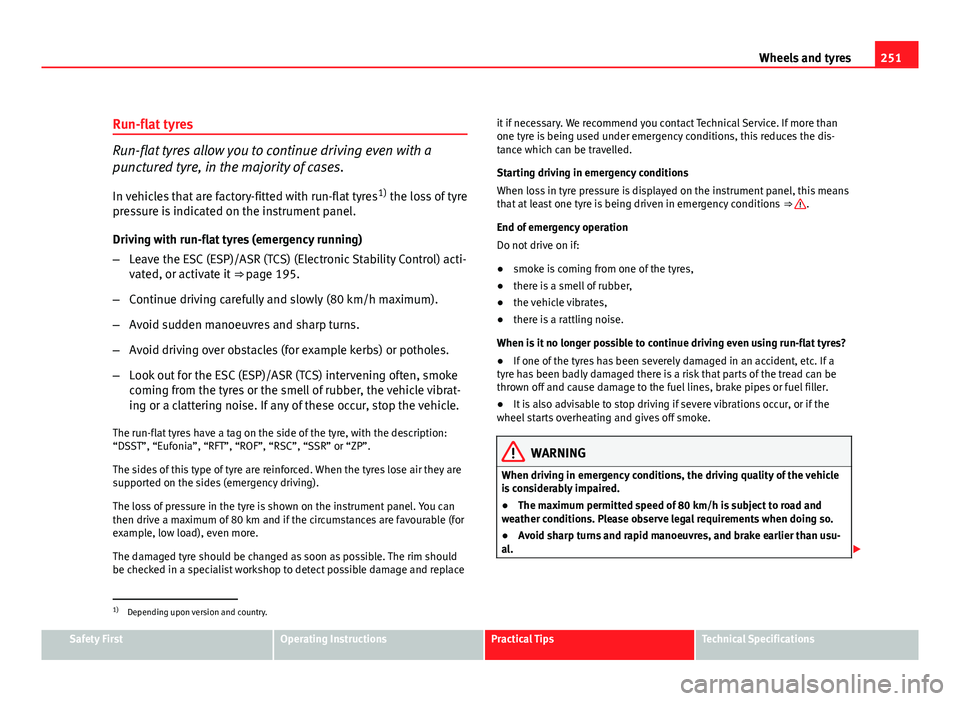
251
Wheels and tyres
Run-flat tyres
Run-flat tyres allow you to continue driving even with a
punctured tyre, in the majority of cases.
In vehicles that are factory-fitted with run-flat tyres 1)
the loss of tyre
pressure is indicated on the instrument panel.
Driving with run-flat tyres (emergency running)
ŌĆō Leave the ESC (ESP)/ASR (TCS) (Electronic Stability Control) acti-
vated, or activate it ŌćÆŌĆŖpage 195.
ŌĆō Continue driving carefully and slowly (80 km/h maximum).
ŌĆō Avoid sudden manoeuvres and sharp turns.
ŌĆō Avoid driving over obstacles (for example kerbs) or potholes.
ŌĆō Look out for the ESC (ESP)/ASR (TCS) intervening often, smoke
coming from the tyres or the smell of rubber, the vehicle vibrat-
ing or a clattering noise. If any of these occur, stop the vehicle.
The run-flat tyres have a tag on the side of the tyre, with the description:
ŌĆ£DSSTŌĆØ, ŌĆ£EufoniaŌĆØ, ŌĆ£RFTŌĆØ, ŌĆ£ROFŌĆØ, ŌĆ£RSCŌĆØ, ŌĆ£SSRŌĆØ or ŌĆ£ZPŌĆØ.
The sides of this type of tyre are reinforced. When the tyres lose air they are
supported on the sides (emergency driving).
The loss of pressure in the tyre is shown on the instrument panel. You can
then drive a maximum of 80 km and if the circumstances are favourable (for
example, low load), even more.
The damaged tyre should be changed as soon as possible. The rim should
be checked in a specialist workshop to detect possible damage and replace it if necessary. We recommend you contact Technical Service. If more than
one tyre is being used under emergency conditions, this reduces the dis-
tance which can be travelled.
Starting driving in emergency conditions
When loss in tyre pressure is displayed on the instrument panel, this means
that at least one tyre is being driven in emergency conditions
ŌćÆŌĆŖ
.
End of emergency operation
Do not drive on if:
ŌŚÅ smoke is coming from one of the tyres,
ŌŚÅ there is a smell of rubber,
ŌŚÅ the vehicle vibrates,
ŌŚÅ there is a rattling noise.
When is it no longer possible to continue driving even using run-flat tyres?
ŌŚÅ If one of the tyres has been severely damaged in an accident, etc. If a
tyre has been badly damaged there is a risk that parts of the tread can be
thrown off and cause damage to the fuel lines, brake pipes or fuel filler.
ŌŚÅ It is also advisable to stop driving if severe vibrations occur, or if the
wheel starts overheating and gives off smoke.
WARNING
When driving in emergency conditions, the driving quality of the vehicle
is considerably impaired.
ŌŚÅ The maximum permitted speed of 80 km/h is subject to road and
weather conditions. Please observe legal requirements when doing so.
ŌŚÅ Avoid sharp turns and rapid manoeuvres, and brake earlier than usu-
al. ’éŻ
1)
Depending upon version and country.
Safety FirstOperating InstructionsPractical TipsTechnical Specifications
Page 258 of 313
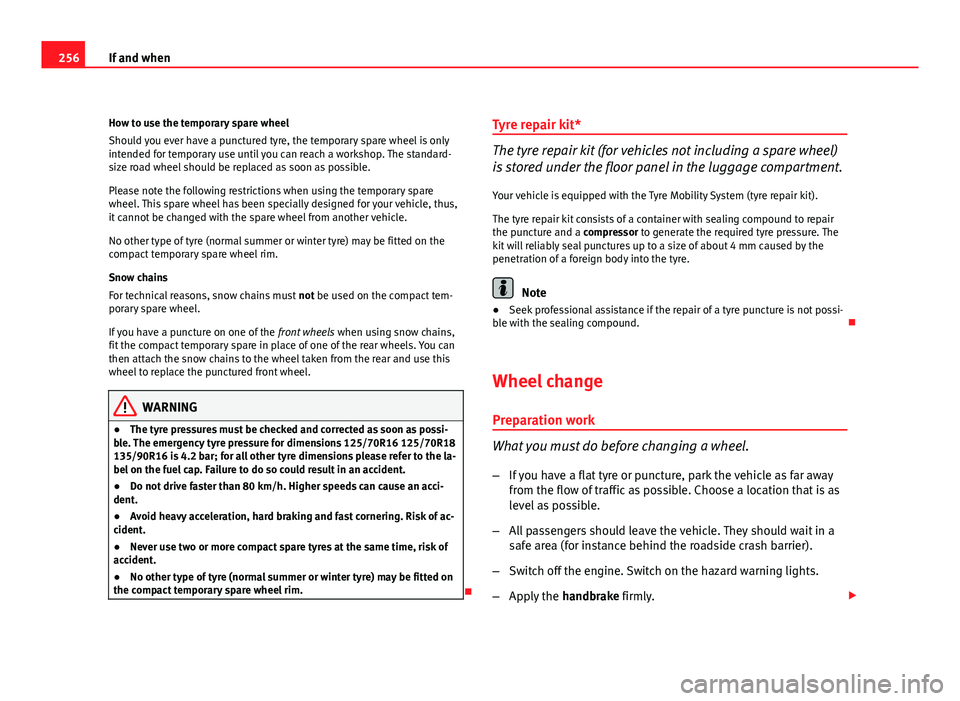
256If and when
How to use the temporary spare wheel
Should you ever have a punctured tyre, the temporary spare wheel is only
intended for temporary use until you can reach a workshop. The standard-
size road wheel should be replaced as soon as possible.
Please note the following restrictions when using the temporary spare
wheel. This spare wheel has been specially designed for your vehicle, thus,
it cannot be changed with the spare wheel from another vehicle.
No other type of tyre (normal summer or winter tyre) may be fitted on the
compact temporary spare wheel rim.
Snow chains
For technical reasons, snow chains must not be used on the compact tem-
porary spare wheel.
If you have a puncture on one of the front wheels when using snow chains,
fit the compact temporary spare in place of one of the rear wheels. You can
then attach the snow chains to the wheel taken from the rear and use this
wheel to replace the punctured front wheel.
WARNING
ŌŚÅ The tyre pressures must be checked and corrected as soon as possi-
ble. The emergency tyre pressure for dimensions 125/70R16 125/70R18
135/90R16 is 4.2 bar; for all other tyre dimensions please refer to the la-
bel on the fuel cap. Failure to do so could result in an accident.
ŌŚÅ Do not drive faster than 80 km/h. Higher speeds can cause an acci-
dent.
ŌŚÅ Avoid heavy acceleration, hard braking and fast cornering. Risk of ac-
cident.
ŌŚÅ Never use two or more compact spare tyres at the same time, risk of
accident.
ŌŚÅ No other type of tyre (normal summer or winter tyre) may be fitted on
the compact temporary spare wheel rim.
’āÉ Tyre repair kit*
The tyre repair kit (for vehicles not including a spare wheel)
is stored under the floor panel in the luggage compartment.
Your vehicle is equipped with the Tyre Mobility System (tyre repair kit).
The tyre repair kit consists of a container with sealing compound to repair
the puncture and a compressor to generate the required tyre pressure. The
kit will reliably seal punctures up to a size of about 4 mm caused by the
penetration of a foreign body into the tyre.
Note
ŌŚÅ Seek professional assistance if the repair of a tyre puncture is not possi-
ble with the sealing compound. ’āÉ
Wheel change Preparation work
What you must do before changing a wheel.
ŌĆō If you have a flat tyre or puncture, park the vehicle as far away
from the flow of traffic as possible. Choose a location that is as
level as possible.
ŌĆō All passengers should leave the vehicle. They should wait in a
safe area (for instance behind the roadside crash barrier).
ŌĆō Switch off the engine. Switch on the hazard warning lights.
ŌĆō Apply the handbrake firmly. ’éŻ
Page 301 of 313
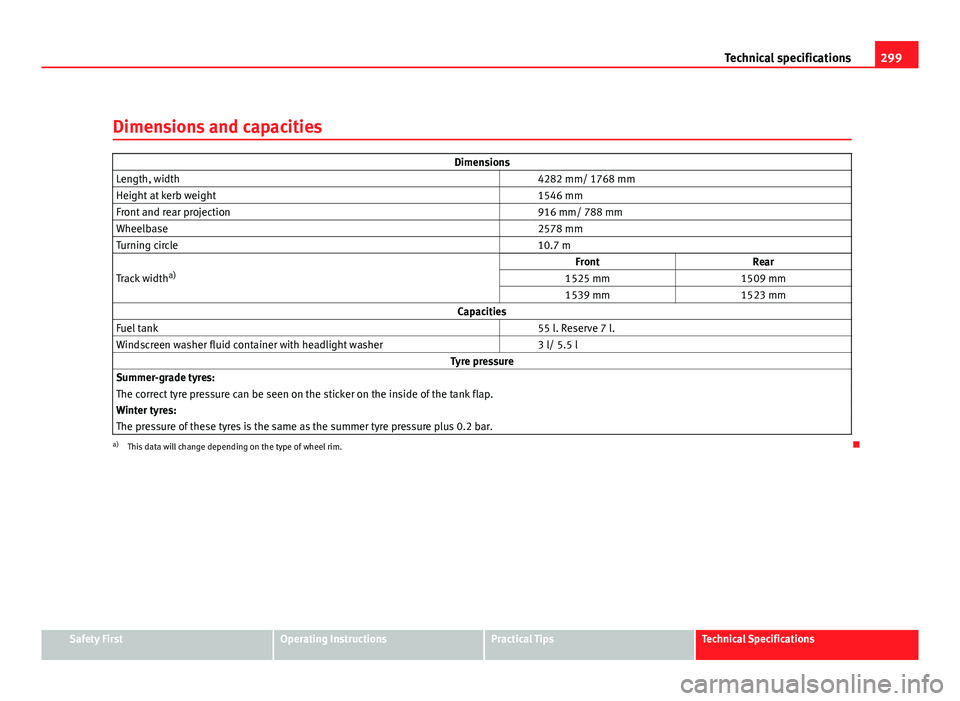
299
Technical specifications
Dimensions and capacities
Dimensions
Length, width 4282 mm/ 1768 mm
Height at kerb weight 1546 mm
Front and rear projection 916 mm/ 788 mm
Wheelbase 2578 mm
Turning circle 10.7 m
Track width a) Front
Rear
1525 mm 1509 mm
1539 mm 1523 mm
Capacities
Fuel tank 55 l. Reserve 7 l.
Windscreen washer fluid container with headlight washer 3 l/ 5.5 l
Tyre pressure
Summer-grade tyres:
The correct tyre pressure can be seen on the sticker on the inside of the tank flap.
Winter tyres:
The pressure of these tyres is the same as the summer tyre pressure plus 0.2 bar.
a) This data will change depending on the type of wheel rim. ’āÉ
Safety FirstOperating InstructionsPractical TipsTechnical Specifications
Page 306 of 313
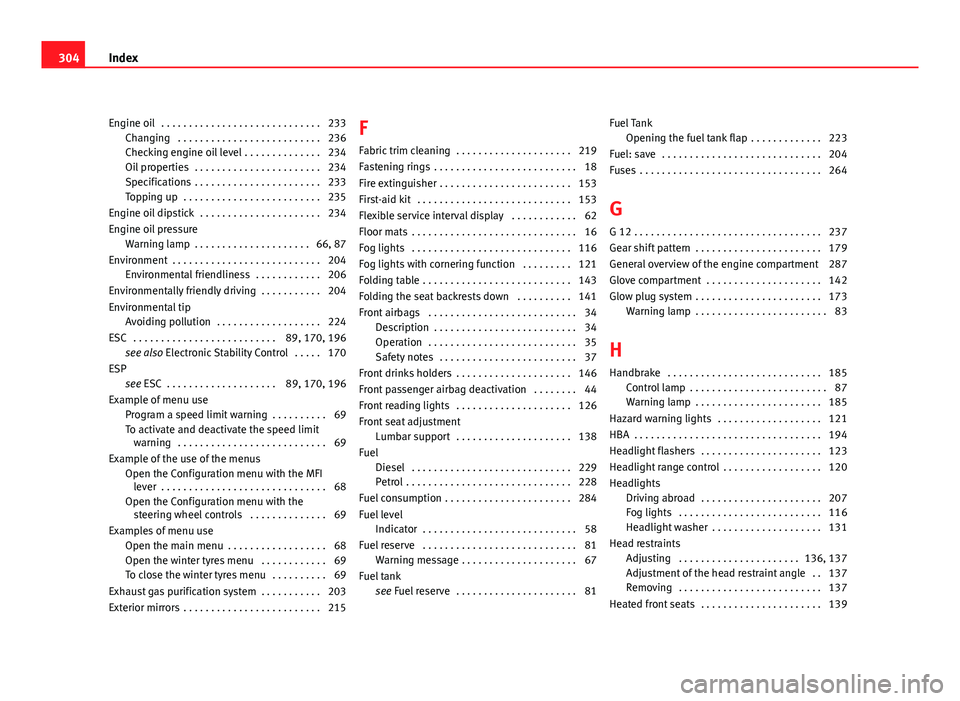
Engine oil . . . . . . . . . . . . . . . . . . . . . . . . . . . . . 233Changing . . . . . . . . . . . . . . . . . . . . . . . . . . 236
Checking engine oil level . . . . . . . . . . . . . . 234
Oil properties . . . . . . . . . . . . . . . . . . . . . . . 234
Specifications . . . . . . . . . . . . . . . . . . . . . . . 233
Topping up . . . . . . . . . . . . . . . . . . . . . . . . . 235
Engine oil dipstick . . . . . . . . . . . . . . . . . . . . . . 234
Engine oil pressure Warning lamp . . . . . . . . . . . . . . . . . . . . . 66, 87
Environment . . . . . . . . . . . . . . . . . . . . . . . . . . . 204 Environmental friendliness . . . . . . . . . . . . 206
Environmentally friendly driving . . . . . . . . . . . 204
Environmental tip Avoiding pollution . . . . . . . . . . . . . . . . . . . 224
ESC . . . . . . . . . . . . . . . . . . . . . . . . . . 89, 170, 196 see also Electronic Stability Control . . . . . 170
ESP see ESC . . . . . . . . . . . . . . . . . . . . 89, 170, 196
Example of menu use Program a speed limit warning . . . . . . . . . . 69
To activate and deactivate the speed limitwarning . . . . . . . . . . . . . . . . . . . . . . . . . . . 69
Example of the use of the menus Open the Configuration menu with the MFIlever . . . . . . . . . . . . . . . . . . . . . . . . . . . . . . 68
Open the Configuration menu with the steering wheel controls . . . . . . . . . . . . . . 69
Examples of menu use Open the main menu . . . . . . . . . . . . . . . . . . 68
Open the winter tyres menu . . . . . . . . . . . . 69
To close the winter tyres menu . . . . . . . . . . 69
Exhaust gas purification system . . . . . . . . . . . 203
Exterior mirrors . . . . . . . . . . . . . . . . . . . . . . . . . 215 F
Fabric trim cleaning . . . . . . . . . . . . . . . . . . . . . 219
Fastening rings . . . . . . . . . . . . . . . . . . . . . . . . . . 18
Fire extinguisher . . . . . . . . . . . . . . . . . . . . . . . . 153
First-aid kit . . . . . . . . . . . . . . . . . . . . . . . . . . . . 153
Flexible service interval display . . . . . . . . . . . . 62
Floor mats . . . . . . . . . . . . . . . . . . . . . . . . . . . . . . 16
Fog lights . . . . . . . . . . . . . . . . . . . . . . . . . . . . . 116
Fog lights with cornering function . . . . . . . . . 121
Folding table . . . . . . . . . . . . . . . . . . . . . . . . . . . 143
Folding the seat backrests down . . . . . . . . . . 141
Front airbags . . . . . . . . . . . . . . . . . . . . . . . . . . . 34 Description . . . . . . . . . . . . . . . . . . . . . . . . . . 34
Operation . . . . . . . . . . . . . . . . . . . . . . . . . . . 35
Safety notes . . . . . . . . . . . . . . . . . . . . . . . . . 37
Front drinks holders . . . . . . . . . . . . . . . . . . . . . 146
Front passenger airbag deactivation . . . . . . . . 44
Front reading lights . . . . . . . . . . . . . . . . . . . . . 126
Front seat adjustment Lumbar support . . . . . . . . . . . . . . . . . . . . . 138
Fuel Diesel . . . . . . . . . . . . . . . . . . . . . . . . . . . . . 229
Petrol . . . . . . . . . . . . . . . . . . . . . . . . . . . . . . 228
Fuel consumption . . . . . . . . . . . . . . . . . . . . . . . 284
Fuel level Indicator . . . . . . . . . . . . . . . . . . . . . . . . . . . . 58
Fuel reserve . . . . . . . . . . . . . . . . . . . . . . . . . . . . 81 Warning message . . . . . . . . . . . . . . . . . . . . . 67
Fuel tank see Fuel reserve . . . . . . . . . . . . . . . . . . . . . . 81 Fuel Tank
Opening the fuel tank flap . . . . . . . . . . . . . 223
Fuel: save . . . . . . . . . . . . . . . . . . . . . . . . . . . . . 204
Fuses . . . . . . . . . . . . . . . . . . . . . . . . . . . . . . . . . 264
G
G 12 . . . . . . . . . . . . . . . . . . . . . . . . . . . . . . . . . . 237
Gear shift pattern . . . . . . . . . . . . . . . . . . . . . . . 179
General overview of the engine compartment 287
Glove compartment . . . . . . . . . . . . . . . . . . . . . 142
Glow plug system . . . . . . . . . . . . . . . . . . . . . . . 173 Warning lamp . . . . . . . . . . . . . . . . . . . . . . . . 83
H Handbrake . . . . . . . . . . . . . . . . . . . . . . . . . . . . 185 Control lamp . . . . . . . . . . . . . . . . . . . . . . . . . 87
Warning lamp . . . . . . . . . . . . . . . . . . . . . . . 185
Hazard warning lights . . . . . . . . . . . . . . . . . . . 121
HBA . . . . . . . . . . . . . . . . . . . . . . . . . . . . . . . . . . 194
Headlight flashers . . . . . . . . . . . . . . . . . . . . . . 123
Headlight range control . . . . . . . . . . . . . . . . . . 120
Headlights Driving abroad . . . . . . . . . . . . . . . . . . . . . . 207
Fog lights . . . . . . . . . . . . . . . . . . . . . . . . . . 116
Headlight washer . . . . . . . . . . . . . . . . . . . . 131
Head restraints Adjusting . . . . . . . . . . . . . . . . . . . . . . 136, 137
Adjustment of the head restraint angle . . 137
Removing . . . . . . . . . . . . . . . . . . . . . . . . . . 137
Heated front seats . . . . . . . . . . . . . . . . . . . . . . 139
304 Index
Page 307 of 313
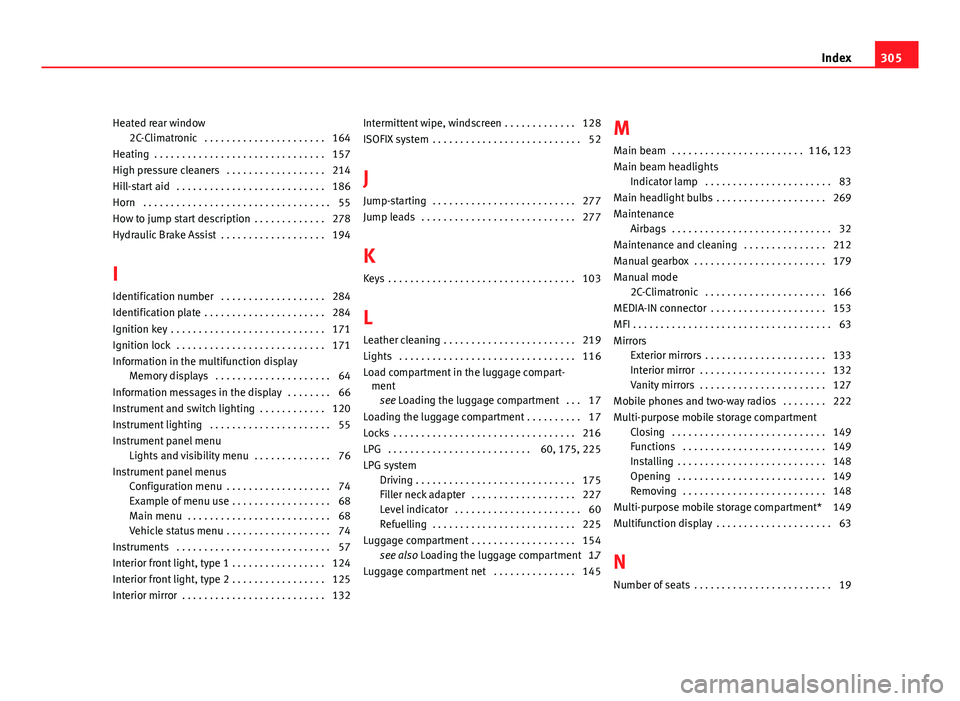
Heated rear window2C-Climatronic . . . . . . . . . . . . . . . . . . . . . . 164
Heating . . . . . . . . . . . . . . . . . . . . . . . . . . . . . . . 157
High pressure cleaners . . . . . . . . . . . . . . . . . . 214
Hill-start aid . . . . . . . . . . . . . . . . . . . . . . . . . . . 186
Horn . . . . . . . . . . . . . . . . . . . . . . . . . . . . . . . . . . 55
How to jump start description . . . . . . . . . . . . . 278
Hydraulic Brake Assist . . . . . . . . . . . . . . . . . . . 194
I
Identification number . . . . . . . . . . . . . . . . . . . 284
Identification plate . . . . . . . . . . . . . . . . . . . . . . 284
Ignition key . . . . . . . . . . . . . . . . . . . . . . . . . . . . 171
Ignition lock . . . . . . . . . . . . . . . . . . . . . . . . . . . 171
Information in the multifunction display Memory displays . . . . . . . . . . . . . . . . . . . . . 64
Information messages in the display . . . . . . . . 66
Instrument and switch lighting . . . . . . . . . . . . 120
Instrument lighting . . . . . . . . . . . . . . . . . . . . . . 55
Instrument panel menu Lights and visibility menu . . . . . . . . . . . . . . 76
Instrument panel menus Configuration menu . . . . . . . . . . . . . . . . . . . 74
Example of menu use . . . . . . . . . . . . . . . . . . 68
Main menu . . . . . . . . . . . . . . . . . . . . . . . . . . 68
Vehicle status menu . . . . . . . . . . . . . . . . . . . 74
Instruments . . . . . . . . . . . . . . . . . . . . . . . . . . . . 57
Interior front light, type 1 . . . . . . . . . . . . . . . . . 124
Interior front light, type 2 . . . . . . . . . . . . . . . . . 125
Interior mirror . . . . . . . . . . . . . . . . . . . . . . . . . . 132 Intermittent wipe, windscreen . . . . . . . . . . . . . 128
ISOFIX system . . . . . . . . . . . . . . . . . . . . . . . . . . . 52
J
Jump-starting . . . . . . . . . . . . . . . . . . . . . . . . . . 277
Jump leads . . . . . . . . . . . . . . . . . . . . . . . . . . . . 277
K
Keys . . . . . . . . . . . . . . . . . . . . . . . . . . . . . . . . . . 103
L
Leather cleaning . . . . . . . . . . . . . . . . . . . . . . . . 219
Lights . . . . . . . . . . . . . . . . . . . . . . . . . . . . . . . . 116
Load compartment in the luggage compart- ment
see Loading the luggage compartment . . . 17
Loading the luggage compartment . . . . . . . . . . 17
Locks . . . . . . . . . . . . . . . . . . . . . . . . . . . . . . . . . 216
LPG . . . . . . . . . . . . . . . . . . . . . . . . . . 60, 175, 225
LPG system Driving . . . . . . . . . . . . . . . . . . . . . . . . . . . . . 175
Filler neck adapter . . . . . . . . . . . . . . . . . . . 227
Level indicator . . . . . . . . . . . . . . . . . . . . . . . 60
Refuelling . . . . . . . . . . . . . . . . . . . . . . . . . . 225
Luggage compartment . . . . . . . . . . . . . . . . . . . 154 see also Loading the luggage compartment . .17
Luggage compartment net . . . . . . . . . . . . . . . 145 M
Main beam . . . . . . . . . . . . . . . . . . . . . . . . 116, 123
Main beam headlights Indicator lamp . . . . . . . . . . . . . . . . . . . . . . . 83
Main headlight bulbs . . . . . . . . . . . . . . . . . . . . 269
Maintenance Airbags . . . . . . . . . . . . . . . . . . . . . . . . . . . . . 32
Maintenance and cleaning . . . . . . . . . . . . . . . 212
Manual gearbox . . . . . . . . . . . . . . . . . . . . . . . . 179
Manual mode 2C-Climatronic . . . . . . . . . . . . . . . . . . . . . . 166
MEDIA-IN connector . . . . . . . . . . . . . . . . . . . . . 153
MFI . . . . . . . . . . . . . . . . . . . . . . . . . . . . . . . . . . . . 63
Mirrors Exterior mirrors . . . . . . . . . . . . . . . . . . . . . . 133
Interior mirror . . . . . . . . . . . . . . . . . . . . . . . 132
Vanity mirrors . . . . . . . . . . . . . . . . . . . . . . . 127
Mobile phones and two-way radios . . . . . . . . 222
Multi-purpose mobile storage compartment Closing . . . . . . . . . . . . . . . . . . . . . . . . . . . . 149
Functions . . . . . . . . . . . . . . . . . . . . . . . . . . 149
Installing . . . . . . . . . . . . . . . . . . . . . . . . . . . 148
Opening . . . . . . . . . . . . . . . . . . . . . . . . . . . 149
Removing . . . . . . . . . . . . . . . . . . . . . . . . . . 148
Multi-purpose mobile storage compartment* 149
Multifunction display . . . . . . . . . . . . . . . . . . . . . 63
N
Number of seats . . . . . . . . . . . . . . . . . . . . . . . . . 19
305
Index